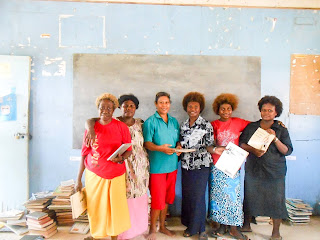TALES OF TANGA
STORY & PICTURES by ITA KEMBA
Most city
slickers pine for places of solitude and quite respite – a place to let down
their hair, put up their feet and get back to basics.
Simple fire
cooked food, fresh air, a dip in the pristine turquoise waters, walking
leisurely along the beach just before the early morning sunrise or at evening twilight
just before the sun dips below the horizon would work wonders for any jaded
spirit.
Or, how about
just getting out on the reefs in the wee hours of the morning and letting down
the line and waiting patiently to see if something’ bites’. Failing that one
could always go long-line fishing, trawling or spear fishing at night.
Well if you are
salivating for just such an experience and that such a place is not just a
figment of one’s imagination then maybe you might consider taking a trip to
Tanga group of Islands way out in the Solomon Sea.
The Islanders
recently sought the help of Pacific Adventist University Information and
Library specialist to help them set up a community Library and Information Center.
They got AUSAID to fund the initiative. The Head Librarian of PAU accepted the
service request and took this trip with some trepidation.
The trip
involved all the three main modes of transportation found in PNG – air, road
and sea.
To get to Tanga
, one takes a 2 hour plane trip to sleepy Kavieng, capital of New Ireland
province, then make a four hour bus ride to Namatanai on the scenic Bulminski
highway, stopping at frequent intervals to tank up with cooked food, kulaus and
the good old buai of course at road side markets that dot the highway.
The cost of the
one way PMV trip is K60 per person. Namatanai, a pit-stop of a rural backwater
town services all the outlying Islands of Lihir, Tabar, Anir, Tanga and west
coast New Ireland from where one could island hop to Duke of York and Kokopo.
Walk down to the
little pier and beach and one sees rows and rows of public marine vessels
(PMV’s) otherwise commonly known as motorized dinghies waiting for their
passengers and hear the skipper and the crew of each vessels call out for
passengers. The scene is reminiscent of Gordon’s PMV bus stop in PNG's rowdy
capital Port Moresby except that you are looking at sea going vessel. One way
trip to Tanga is K100 per head.
The trip takes 4
hours on a calm day and longer when the weather is frightful.
For landlubbers
the prospect of going out without a chart or a compass and finding a little dot
out in the trackless sea and making landfall safely can be a little daunting.
Whether day or night, it makes little difference to these sea-faring folks.
The not too
comforting knowledge is that Tangans have often found themselves in places
other than their home Island once too often – one instance floating all the way
to Kiribati!
The Tanga groups
of Islands are in fact 4 Islands, Moang, Big Tanga, Anir and Tefa. For a remote
community the Islands a pretty well endowed with good level of services. One
High School, three primary schools, 7
elementary schools, a fully staffed rural health centre with outpatient wing,
male and female wards, maternity ward and children’s ward and 6 qualified health professional
could be considered ‘rich’ by anyone’s standard in PNG.
But they also
boast satellite phone communication, internet access and incredibly - permanent
public toilets which is septic! All high school teachers’ accommodation has
water tanks plus septic toilets. Primary teacher’s accommodations are also
reasonably good, have Tuffa water tanks
but lack the septic toilet facilities.
The whole
community’s law and order issues are handled by one lone policeman on the
Island. If its sounds like a holiday camp – you be the judge. They also have
several guest houses on the Island with conference facilities; the guest rooms
are all self-contained.
The community’s
main source of income is fish usually bound for Lihir, failing that the
Islanders take their catch to Namatanai or Kavieng. The Islander’s good fortune
could be put down to having a supportive son in Governor Sir Julius Chan. Lihir mine royalties could also be a
contributing factor for the Islands having a decent and perhaps above average
services. The communities have resisted the overtures of mining companies
wishing to take up mine lease on the Island
Tanga is quiet
with little evidence of problems afflicting other communities around PNG.
Homebrew, marijuana use and consumption, drunkenness relating to alcohol
consumption are not visible, perhaps due in part to the enduring chiefly system
and also as a result of their remoteness.
While many
elements of Tanga Island life and environment could stick out in the minds of those
who have the means and the fortitude to make the trip, for this visitor at
least, it was the hospitality and service of a certain host called Scollie that
lingers on long after the trip. Each morning Scollie would get out to the reef,
throw a baited line, bring the catch home and within an hour would present her
guest with a charcoal cooked fish and taro Kongkong all piping hot and before
8:00am!
Ah, that is
called ‘sterling service’ and for that alone one would be happy to make the
return trip for a repeat service.
All good things
must come to end and so after conducting a series of workshops on how to set up
community libraries with five willing female participants, the facilitator had
to reluctantly bid adios and make her way back to “civilization”. Sometimes one
wonders who really leads a civilized life; those residents in Tanga or those
residents in the suburbs of Port Moresby. My pick by a country mile would be
Tanga Islanders!
Adieu Tanga!













No comments:
Post a Comment